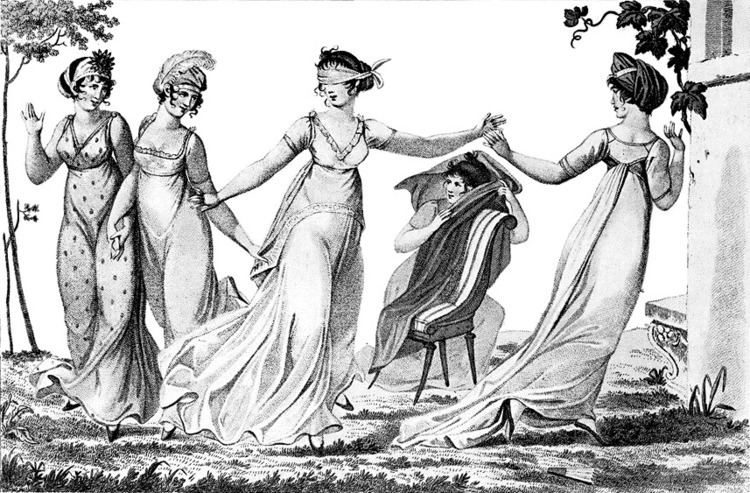 | ||
Blind man's buff or blind man's bluff is a variant of tag in which the player who is "It" is blindfolded. The traditional name of the game is "blind man's buff", where the word buff is used in its older sense of a small push. The game later also became known as "blind man's bluff"; it is possible that this name is a linguistic corruption.
Contents
Gameplay
Blind man's buff is played in a spacious area, such as outdoors or in a large room, in which one player, designated as "It", is blindfolded and gropes around attempting to touch the other players without being able to see them, while the other players scatter and try to avoid the person who is "it", hiding in plain sight and sometimes teasing them to make them change direction.
Blind man's buff is ideally played in an area free of dangerous obstructions so that the "It" player will not suffer injury from tripping over or hitting something.
Versions
There are several versions of the game:
History
A version of the game was played in Ancient Greece where it was called "copper mosquito." The game is played by children in Bangladesh known as Kanamaachhi [কানামাছি] meaning blind fly. One individual is blind-folded in order to catch or touch one of the others who run around repeating, “The blind flies are hovering fast! Catch whichever you can!” The game has been known to be played since during the Tudor period, as there are references to its recreation by Henry VIII's courtiers. It was also a popular parlor game in the Victorian era. The poet Robert Herrick mentions it, along with sundry related pastimes, in his poem "A New Yeares Gift Sent to Sir Simeon Steward":
It is also played in many areas in Asia including Afghanistan and all over Europe including Germany.
Similar games
A children's game similar to blind man's buff is Marco Polo. Marco Polo is usually played in a swimming pool; the player who is "it" shuts their eyes and calls out "Marco" to which the other players must reply "Polo", thus indicating their positions and making it easier for "it" to go in the right direction.
Another children's game similar to blind man's buff is Dead Man. The player who is "it" closes their eyes rather than wearing a blindfold.
-
Another game is Hide and clap inspired by the film The Conjuring. Where one person is "it" and they are blindfolded and trying to find other players. The players who are hiding get to clap 3 times. 1st claps and the one that is "it" has to try to locate the player by the noise of the claps. If the "it" player can't locate them, they ask for the 2nd clap and start searching again by the noise of the claps. If the "it" player still can't locate the other players the "it" player asks for the last 3rd clap. Very similar to Blind man's buff and Marco Polo.
